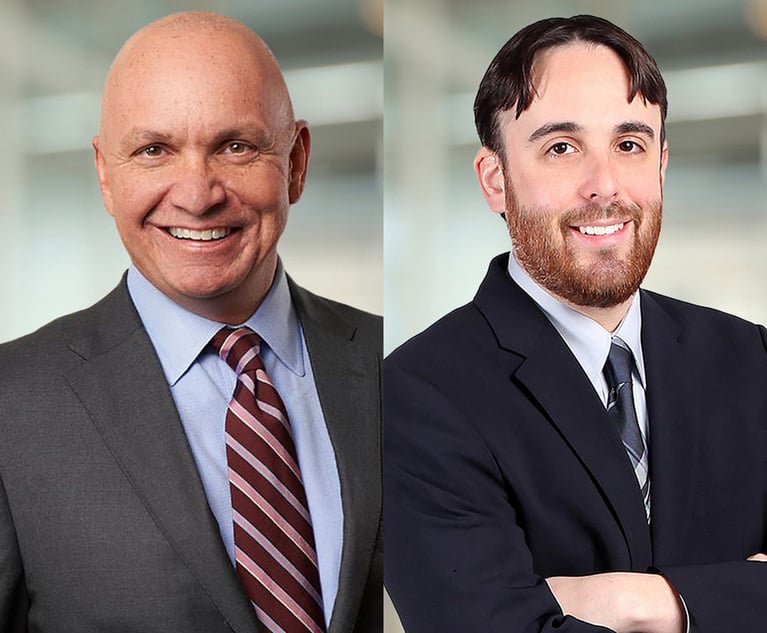
Avoiding Avoidance Actions in Bankruptcy
A top-level summary of the legal standards for recovering on avoidance actions, and the defenses and strategies available to parties who are the targets of such litigation.
March 02, 2022 at 10:00 AM
9 minute read
For most non-bankruptcy attorneys, their first experience in bankruptcy court could very likely begin with a call from an agitated and bewildered client asking for help to understand why they have been sued by a trustee in a bankruptcy case filed by one of its customers. Even worse, the client's incredulity may only be exacerbated by the fact this same customer still owes your client money! This is when a basic working knowledge of avoidance actions in bankruptcy cases would be extremely helpful.
For bankruptcy trustees and Chapter 11 debtors-in-possession (and for purposes of this article we will only refer to trustees as the terms in this context are interchangeable) an important aspect of any bankruptcy case—indeed a chief source of recovery for any bankruptcy estate—is the availability to the trustee of avoidance actions. These are legal actions to recover money or property that was transferred by the debtor before the bankruptcy case was filed. There are several types of avoidance actions that are covered by the Bankruptcy Code that can be pursued by a trustee. The most common of these are preferences and fraudulent transfers. In this article we will provide a top-level summary of the legal standards for recovering on avoidance actions, and the defenses and strategies available to companies or individuals that are the unfortunate targets of such litigation.
Section 547 of the Bankruptcy Code permits a trustee to recover, or claw back, a preference, which is generally a payment made by the debtor to any party within 90 days of the bankruptcy filing that was made on account of an existing debt. These actions target creditors who were paid, partially or in full, prior to the commencement of the bankruptcy.
This content has been archived. It is available through our partners, LexisNexis® and Bloomberg Law.
To view this content, please continue to their sites.
Not a Lexis Subscriber?
Subscribe Now
Not a Bloomberg Law Subscriber?
Subscribe Now
NOT FOR REPRINT
© 2025 ALM Global, LLC, All Rights Reserved. Request academic re-use from www.copyright.com. All other uses, submit a request to [email protected]. For more information visit Asset & Logo Licensing.
You Might Like
View All
Topping Kirkland, Weil Won the Most Valuable Major Bankruptcy Retentions of 2024

How New Jersey’s Pragmatic Bankruptcy Approach Sets It Apart Post-'Purdue Pharma'
7 minute read
Trending Stories
- 1Brogdon: The Final Nail in Corbin’s Coffin in Premises Cases
- 2What to Know About the New 'Overlapping Directorship' Antitrust Development
- 3'Quiet, Appropriate End:' NY Court of Appeals Formally Removes Erin Gall From Bench
- 4Just One Cookie? Justices to Decide Liability for Half-Truths
- 540% Contingency: A New Ruling Just Cost This Plaintiff Team $827K in Legal Fees
Who Got The Work
Michael G. Bongiorno, Andrew Scott Dulberg and Elizabeth E. Driscoll from Wilmer Cutler Pickering Hale and Dorr have stepped in to represent Symbotic Inc., an A.I.-enabled technology platform that focuses on increasing supply chain efficiency, and other defendants in a pending shareholder derivative lawsuit. The case, filed Oct. 2 in Massachusetts District Court by the Brown Law Firm on behalf of Stephen Austen, accuses certain officers and directors of misleading investors in regard to Symbotic's potential for margin growth by failing to disclose that the company was not equipped to timely deploy its systems or manage expenses through project delays. The case, assigned to U.S. District Judge Nathaniel M. Gorton, is 1:24-cv-12522, Austen v. Cohen et al.
Who Got The Work
Edmund Polubinski and Marie Killmond of Davis Polk & Wardwell have entered appearances for data platform software development company MongoDB and other defendants in a pending shareholder derivative lawsuit. The action, filed Oct. 7 in New York Southern District Court by the Brown Law Firm, accuses the company's directors and/or officers of falsely expressing confidence in the company’s restructuring of its sales incentive plan and downplaying the severity of decreases in its upfront commitments. The case is 1:24-cv-07594, Roy v. Ittycheria et al.
Who Got The Work
Amy O. Bruchs and Kurt F. Ellison of Michael Best & Friedrich have entered appearances for Epic Systems Corp. in a pending employment discrimination lawsuit. The suit was filed Sept. 7 in Wisconsin Western District Court by Levine Eisberner LLC and Siri & Glimstad on behalf of a project manager who claims that he was wrongfully terminated after applying for a religious exemption to the defendant's COVID-19 vaccine mandate. The case, assigned to U.S. Magistrate Judge Anita Marie Boor, is 3:24-cv-00630, Secker, Nathan v. Epic Systems Corporation.
Who Got The Work
David X. Sullivan, Thomas J. Finn and Gregory A. Hall from McCarter & English have entered appearances for Sunrun Installation Services in a pending civil rights lawsuit. The complaint was filed Sept. 4 in Connecticut District Court by attorney Robert M. Berke on behalf of former employee George Edward Steins, who was arrested and charged with employing an unregistered home improvement salesperson. The complaint alleges that had Sunrun informed the Connecticut Department of Consumer Protection that the plaintiff's employment had ended in 2017 and that he no longer held Sunrun's home improvement contractor license, he would not have been hit with charges, which were dismissed in May 2024. The case, assigned to U.S. District Judge Jeffrey A. Meyer, is 3:24-cv-01423, Steins v. Sunrun, Inc. et al.
Who Got The Work
Greenberg Traurig shareholder Joshua L. Raskin has entered an appearance for boohoo.com UK Ltd. in a pending patent infringement lawsuit. The suit, filed Sept. 3 in Texas Eastern District Court by Rozier Hardt McDonough on behalf of Alto Dynamics, asserts five patents related to an online shopping platform. The case, assigned to U.S. District Judge Rodney Gilstrap, is 2:24-cv-00719, Alto Dynamics, LLC v. boohoo.com UK Limited.
Featured Firms
Law Offices of Gary Martin Hays & Associates, P.C.
(470) 294-1674
Law Offices of Mark E. Salomone
(857) 444-6468
Smith & Hassler
(713) 739-1250







